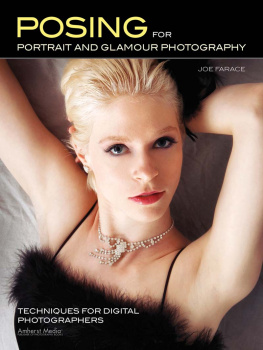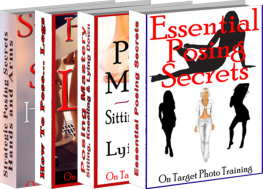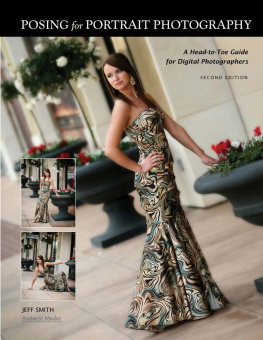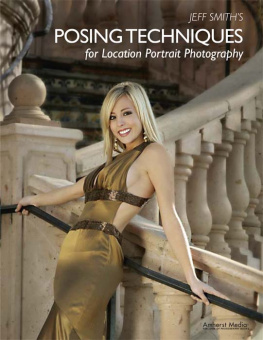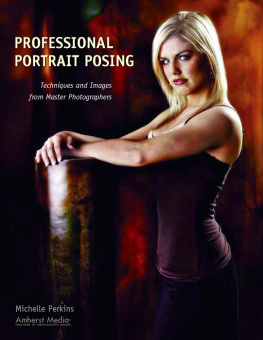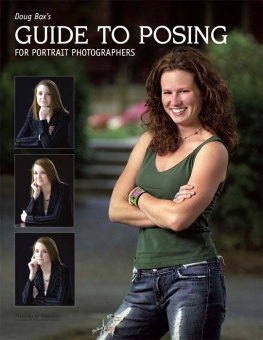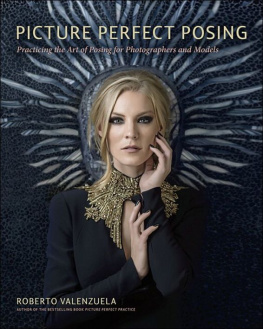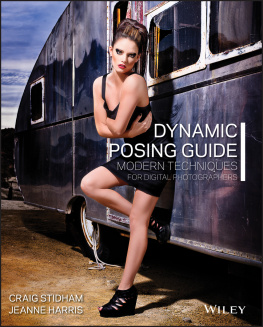DEDICATION
This book is dedicated to Jay Perskie of Perskie Photographics (www.perskie.com), who started me on this journey. It was Jay who took an amateur photographer, introduced me to the concepts of lighting and posing, and set me out on the path of becoming a professional photographer. Thanks, Jay!
Copyright 2013 by Joe Farace.
All photographs by the author unless otherwise noted.
All rights reserved.
Published by:
Amherst Media, Inc.
P.O. Box 586
Buffalo, N.Y. 14226
Fax: 716-874-4508
www.AmherstMedia.com
Publisher: Craig Alesse
Senior Editor/Production Manager: Michelle Perkins
Assistant Editor: Barbara A. Lynch-Johnt
Editorial assistance: Sally Jarzab, John S. Loder, and Carey A. Miller.
ISBN-13: 978-1-60895-548-0
Library of Congress Control Number: 2012936518
Printed in the United States of America.
10 9 8 7 6 5 4 3 2 1
No part of this publication may be reproduced, stored, or transmitted in any form or by any means, electronic, mechanical, photocopied, recorded or otherwise, without prior written consent from the publisher.
Notice of Disclaimer: The information contained in this book is based on the authors experience and opinions. The author and publisher will not be held liable for the use or misuse of the information in this book.
| Check out Amherst Medias blogs at: | http://portrait-photographer.blogspot.com/http://weddingphotographer-amherstmedia.blogspot.com/ |
Contents


Acknowledgments
T his book is the fourth that I have written for Amherst Media and the reason for that is simple: they are a great bunch of people who are as passionate about photography as their writers. A big thank you goes out to dynamic publisher Craig Alesse at Amherst Media for suggesting the concept for a book about posing and giving me a chance to write this book.
A big thank you goes out to Barbara A. Lynch-Johnt for designing the four before and after posing sequences (The Polished Portrait) that appear in the book. Barbaras design was implemented by Mary Farace, who directed all of the actual poses during the four different shoots that produced the images that you see. Big thanks also to the wonderful Pam Simpson for posing for these sessions. I merely set up the background and lighting and clicked the shutter; these talented ladies did all the hard work.
I wanted this book to feature some images made by other photographers to show that theres more than one approach to posing, and I would like to thank the following people who contributed photographs, making this book more comprehensive than it would have otherwise been. This includes my wife, Mary Farace, who not only made some of the portraits in this book but was kind enough to pose for a few of them as well, and WKH Photographys (www.wkhphotography.com) Kent Hepburn, whose glamour photography exudes a wholesome sensuality. I would also like to thank Kevin Elliott of DigitalMD (www.digitalmd.net) for bailing me out of technical and creative problems during the time this book was in progress and for his assistance over the many years that I have known him. An especially big thank you goes out to all of the different people who posed for the photographs that appear in this book. Photographing people is a shared endeavor, and I owe a huge debt of gratitude to all of them.
Lastly, I would like to again thank my wonderful wife Mary, who is an outstanding people photographer in her own right and who, over the years, has taught me a lot about posing and lighting. Mary is as much responsible for all of the good stuff thats in this book as anyone, and Im grateful for her love and support. I alone am responsible for all the mistakes and goofs.
About the Author
J oe Faraces interest in digital imaging combines an engineering education from Johns Hopkins University with photography training he acquired at the Maryland Institute, College of Art. Joe is the author of thirty-three other books about photography, digital imaging, and the business of photography. He is Contributing Writer and Photographer to Shutterbug magazine, which publishes his monthly Digital Innovations and Web Profiles columns. His writing occasionally appears in several other domestic and foreign magazines and blogs. Joes honors include the Photographic Craftsmans Award presented by the Professional Photographers of America and Honorary Membership from the Independent Photographers of Colorado for dedication and service to the photographic community.
Please visit his how-to blog (www.joefaraceblogs.com) where he posts daily, providing a photographic tip, tool, or technique. Joe also hosts an automobile photography site (www.joefaraceshootscars.com). You can also follow Joe on Twitter at www.twitter.com/joefarace or on Facebook.

Ideas for poses can come from many different sources. This photo was made after a birthday dinner in Lafayette, Colorado. It had just stopped raining, and as I walked past this lamppost, I thought of Gene Kelly in Singing in the Rain and struck this pose. This image was taken with a Canon Powershot SD10. The EXIF data for the image shows an exposure of 1/50 second at f/2.8 and ISO 400. Nik Softwares (www.niksoftware.com) Silver Efex Pro was used to convert the image to black & white in order to downplay the distracting background. 2012 Mary Farace.
Introduction
A photographic portrait is a picture of someone who knows he is being photographed.
Richard Avedon
T he above quote shows that the late Richard Avedon was not only a genius behind a camera but was unusually perceptive about his photographs and what they represented. The truth is, a portrait seldom represents reality. Instead, its a snapshot of a point in time and, with retouching and posing, presents an idealized version of someone who knows they are being photographed. The point of any pose is not just to look natural (thats a lofty objective) but to tell a storyand there are many ways you can pursue that goal. Some like to keep their posing subtle (thats my preferred way of working), while others are not so restrained. Yousef Karshs famous portrait of Winston Churchill was made during a two-minute session in which Karsh gently and politely removed the ever-present cigar from Churchills mouth to produce the determined look you see in the photograph. No matter how you achieve the pose, it all starts with observation, communication, and experience. I can help you with the first two, but the third is up to you because, as the punchline to an old joke says, the best way to get to Carnegie Hall is practice, man, practice.

Heres a quick introduction to two of my favorite posing tips: (1) If theres something that your subject can lean on, have them do it. It gives them something to do with their hands. In this case, the subject angled her body, making the pose more dynamic than it would have been if she were standing straight. (2) When shooting a glamour-style image, I sometimes ask the subject to act as if shes ripping her clothes off. Im never more specific than that. I let the model interpret the suggestion in her own way and almost always refine the pose that she comes up with in subsequent shots. Here, that wasnt necessary. This image was made with a Canon EOS 50D camera and an EF 28-105mm lens. The program mode exposure was 1/60 second at f/5 and ISO 200. A 550EX Speedlite provided fill.

